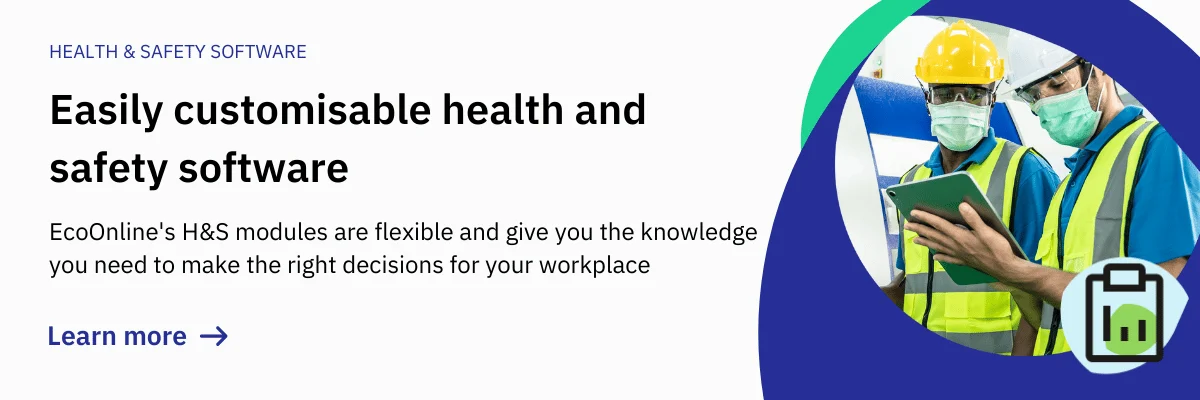11 Fundamentals of Health and Safety Excellence

Truly embodying health and safety excellence is a difficult task, no matter your industry, company size or experience. While it’s hard to settle on a set of qualifications that encompass health and
safety excellence, EcoOnline’s experts have determined a good place to start.
Here you’ll learn about the eleven fundamentals of health and safety excellence. The video clips have been pulled from a webinar we hosted for our community. While EHS software can expedite the process of crafting an ideal safety culture, focus on incorporating these eleven principles, one at a time and with intention. Over a longer period, you’ll see the payoff.
1: Commitment
Health and safety excellence requires an organization’s top management to commit to safe operations and practices. Without buy-in and demonstrative action from the top leaders, it will be hard to see safe practices trickle down through the ranks. As such, this commitment must be visible.
You can ensure visibility through clear communication across multiple platforms known within the organization. Additionally, dedicate your organization to zero-harm practices and operations, and make it clear the employees and contractors that your utmost priority is that they return home safe and healthy each and every day.
2: Operation Capability
For any health and safety culture to be truly successful, safety must be considered in all aspects of systems design and operation. Working procedures and guidelines must fully incorporate health and safety precautions.
To ensure this cohesive design, consider the interaction between employees and operations during the earliest planning stages. You’ll also want to maintain a focus on safety improvement efforts at all times.
3: True Understanding of Risk and Criticality
Organizations with strong safety cultures have a deep understanding of what resources are required to manage risks – at all levels of severity – from operations. They have systems in place to assess operational risks as well as risks that may occur due to human error. Hazards and risks should be periodically assessed for all types of work activities in the organization.
4: Dealing with Crises and Learning From Them
Companies with strong safety cultures understand that emergencies and incidents could occur at any time, and they have robust systems in place to immediately begin handling them. These systems ensure effective methods of communicating these incidents internally and have the methodologies and know-how to investigate and understand the root causes.
Most importantly, organizations with strong safety cultures learn from crises and ensure they never happen again. They also have procedures for dealing with emergency escalation and large-scale disasters.
5: Harnessing Technology where Justifiable
Organizations with strong safety cultures are open to change and are always seeking the best ways to ensure that safety management is efficiently carried out. These organizations research the safety management technologies at their disposal to determine which could provide the best return on investment. They seek to increase efficiency in incident reporting, behavioural observations, accident investigations, training and more with technology.
6: Training, Competence and Developing a coach approach
Strong safety cultures require strong health and safety competencies, which must be instilled immediately when an employee joins the company. In addition to good technical competencies, these organizations put a strong emphasis on leadership and initiative.
To ensure their safety culture is consistently maintained, they make sure supervisors have the right leadership attributes and can coach employees to maintain the correct, safe behaviors.
7: Understanding Behaviors and Working to Influence them
To maintain a strong safety culture, it is important to understand the at risk behaviors that could result in potential future incidents. Organizations with strong health and safety cultures analyze their behaviors the intent to reduce at-risk behaviors and increase safe behaviors. In addition to using technology to analyze trends in behaviors, they train and coach employees to be involved in their program using tried and true methods of engagement. They also understand – and communicate – that it is everyone’s responsibility to ensure safe behavior, not just one manager or employee.
Engaging your workforce is no small task. While it is one of these eleven critical steps toward crafting a strong safety culture and safety excellence within your organization, you should dedicate time and energy to figuring out how to best connect with your employees on this topic. Learn more about how you can do so here.
8: Collective Decision Making Through Health and Safety Committees
Organizations with strong safety cultures nearly always have health and safety committees. These groups of employees make decisions that have a significant influence on the overall direction of the organization regarding safety initiatives. Some of the more established committees make decisions on how and where health and safety budgets should be spent.
One thing all these committees across companies have in common is that they give decision-making power to employees themselves; that is the purpose of these committees. They can address the concerns of employees by giving power to them. The contributions of individuals are noted, and action items are designated to individuals on the committee for follow-up and review.
9: Strong Focus on Health and General Employee Welfare
These organizations understand that the strength of their safety culture and overall success is down to their employees. Employee and contractor health and welfare, as well as their safety at work, is treated as the utmost priority. On many occasions, such companies go beyond workplace safety to initiate programs for the welfare of their employees and families beyond the workplace, too.
10: Appreciate the Role of Good PR in Health and Safety
Companies that have strong health and safety performances are proud of this fact and often publicize it using internal or external teams. Publicizing their good record can uplift the spirits of the group as a whole and helps nurture continuity of these safe behaviours. Good internal communication methods that bring awareness to the importance of working safely are key in this, too.
11: Working to Develop the Wider Community
One of the hallmarks of a company with a strong safety culture is that they encourage their wider community to be safer as well. They get involved with events, provide speakers, and support ongoing initiatives in their community. One of the best ways to instill good behaviors is to have individuals practice applying their skills – health and safety is no different.
CHAPTER 1
Conclusion
Crafting a safety culture that encompasses each of these eleven aspects will take time. There is no overnight fix for a weak safety culture. EcoOnline’s EHS software solutions can help you create this ideal culture.
With our software, you can engage employees with mobile and frictionless data capture and reporting, continuously approve with easily customizable modules, make informed decisions using dashboards updated in real-time, and build safer behaviors among employees with e-learning and trainings. Do not wait to begin crafting a safer workplace culture, start today.













